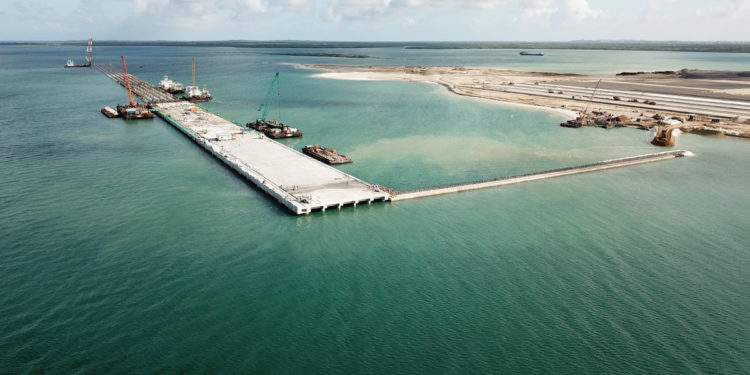The government is making final preparations to have domestic importers use the second transport corridor through Lamu port. One lane of the 10 Kilometres dual carriageway road linking the port to the main highway is complete with the construction of the other lane underway to provide the necessary linkage for cargo evacuation out of the port.
“The construction of the Lamu – Garsen – Witu road has also registered tremendous progress and it is our hope that this shall be finalized soon,” Arch Daniel Manduku, the Kenya Ports Authority managing director said in an email interview.
There is existing road that can be used for the early evacuation of cargo from the port with shippers having a choice to either take their cargo through Garissa – Thika, Nairobi or via Malindi.
The first berth at Lamu port is now complete together with a container yard with a holding capacity of over 21,000 Twenty Foot Equivalent Units (TEUs).
“Final preparation of the yards is on-going, and it is expected to be complete soon and hopefully a new date for commissioning of the new port and subsequent operationalization shall be announced,” Manduku said, adding that that the Maersk Shipping Line has already committed to call in the first vessel.
The other supporting infrastructures such as the causeway, aids to navigation, security requirements including fencing of the yard and International Ships and Port Facility Security (ISPS) Code compliance as well as deployment of staff and equipment are at advanced stage.
KPA has been able to gazette the port as a customs area and allocated a section for a temporary warehouse as well as marked another area for transshipment cargo that is what the authority is encouraging in the initial period of its operations.
“We also have staff from Kenya Revenue Authority (KRA), Kenya Bureau of Standards (Kebs) and Port Health among other key agencies involved in cargo clearance already posted in Lamu,” Manduku said.
Though the initial target of the new port is transit and transshipment cargo, Lamu port is expected to play a complimentary role to Mombasa Port. This shall provide an alternative route or option for shippers who might want to take advantage of the promotional tariff and revive the transportation sector, Manduku said.
“We also hope and shall continue to encourage business communities of northern region’s Counties of Garissa and Isiolo and of course Lamu to import and export their goods including livestock and fish through this port,” he said, adding that Lamu has also a great potential for cruise tourism.
Ultimately, and with a good road infrastructure in place, we expect to undertake a deliberate marketing initiative to lure our transit countries of Ethiopia and South Sudan which is the main objective of opening the new LAPSSET Corridor.
When the project was conceived over a decade ago, the project consultants, in their concept paper, identified six components of the project. In order to become a transportation and commercial hub for the region, Kenya would have to, at a minimum, develop: (a) a commercial port of international standards capable of handling high volumes of containers and other goods traffic; (b) a free trade zone along with the port to foster the growth of trade and commercial activity to make the area a commercial hub; (c) a new beach resort city having facilities of international standards for native and international tourists; (d) an airport capable of being an air hub for the region; (e) a railway network to enable movement of goods from the port and the free trade zone to other parts of Kenya and the countries of the region; and (f) a road highway network to support the capacity of the railway network and provide for greater movement of goods into more areas.
All this project are in the pipeline. However, special priority has been given to the Port, Highways, Pipeline and SEZ, according to Manduku.
The focus for Lamu Port is to serve the Southern part of Ethiopia. Lamu Port has comparative advantage over the ports in Djibouti, Eritrea and Somalia. In terms of distance, Lamu is closer to Southern Ethiopia than the other three. Additionally, the Port of Lamu has a large capacity and will be able to serve the targeted markets efficiently.
Lamu Port is being developed as a global mega port at a green site. The Port is planned to take full advantage of current shipping trends and global benchmarks.
Phase 1 involves construction of the first three (3) berths with a depth of -17.5 meters and a length of 400 meters. Upon completion, the terminal will have a capacity of 2,000,000 TEUs and 24 million tons.
According to the Port Master Plan, it is expected that part of the cargo demand growth for the pot of Mombasa will be diverted to Lamu as a result of capacity constraint.
The shift is expected for commodities that require a lot of space including containers, vehicles and general cargo. No shift is expected for dry bulk and liquid bulk as there will be enough terminal capacity to handle the commodities at the port of Mombasa.
The port of Lamu will be developed on the LAPSSET Master Plan. It will be developed in phases to match the demand with the capacity. The first three berths which are financed by the government of Kenya will be completed by the end of the year 2020.
For any feedback, contacts us via editorial@feaffa.com / info@feaffa.com; Mobile: +254703971679 / +254733780240




